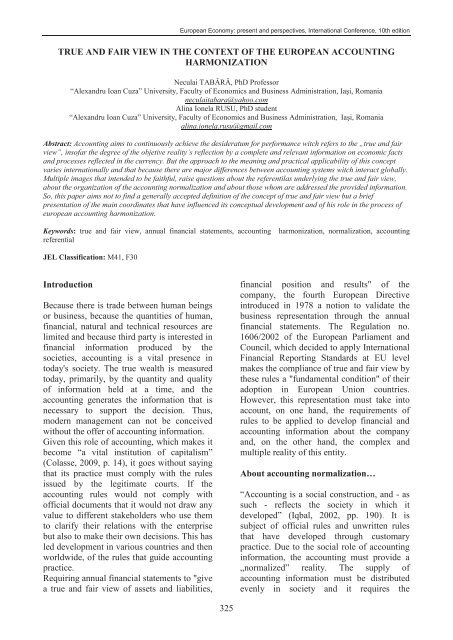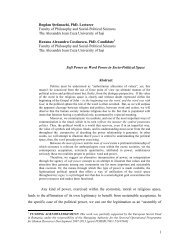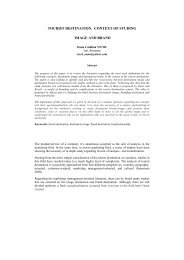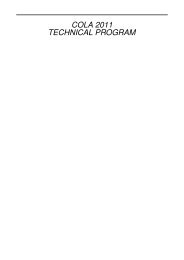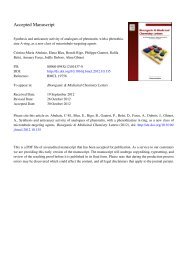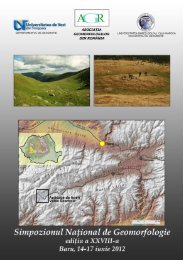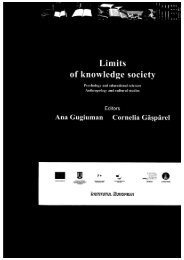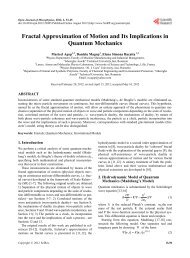325 TRUE AND FAIR VIEW IN THE CONTEXT OF THE EUROPEAN ...
325 TRUE AND FAIR VIEW IN THE CONTEXT OF THE EUROPEAN ...
325 TRUE AND FAIR VIEW IN THE CONTEXT OF THE EUROPEAN ...
Create successful ePaper yourself
Turn your PDF publications into a flip-book with our unique Google optimized e-Paper software.
European Economy: present and perspectives, International Conference, 10th edition<strong>TRUE</strong> <strong>AND</strong> <strong>FAIR</strong> <strong>VIEW</strong> <strong>IN</strong> <strong>THE</strong> <strong>CONTEXT</strong> <strong>OF</strong> <strong>THE</strong> <strong>EUROPEAN</strong> ACCOUNT<strong>IN</strong>GHARMONIZATIONNeculai TABĂRĂ, PhD Professor“Alexandru Ioan Cuza” University, Faculty of Economics and Business Administration, Iaşi, Romanianeculaitabara@yahoo.comAlina Ionela RUSU, PhD student“Alexandru Ioan Cuza” University, Faculty of Economics and Business Administration, Iaşi, Romaniaalina.ionela.rusu@gmail.comAbstract: Accounting aims to continuously achieve the desideratum for performance witch refers to the „true and fairview”, insofar the degree of the objetive reality’s reflection by a complete and relevant information on economic factsand processes reflected in the currency. But the approach to the meaning and practical applicability of this conceptvaries internationally and that because there are major differences between accounting systems witch interact globally.Multiple images that intended to be faithful, raise questions about the referentilas underlying the true and fair view,about the organization of the accounting normalization and about those whom are addressed the provided information.So, this paper aims not to find a generally accepted definition of the concept of true and fair view but a briefpresentation of the main coordinates that have influenced its conceptual development and of his role in the process ofeuropean accounting harmonization.Keywords: true and fair view, annual financial statements, accountingreferentialharmonization, normalization, accountingJEL Classification: M41, F30IntroductionBecause there is trade between human beingsor business, because the quantities of human,financial, natural and technical resources arelimited and because third party is interested infinancial information produced by thesocieties, accounting is a vital presence intoday's society. The true wealth is measuredtoday, primarily, by the quantity and qualityof information held at a time, and theaccounting generates the information that isnecessary to support the decision. Thus,modern management can not be conceivedwithout the offer of accounting information.Given this role of accounting, which makes itbecome “a vital institution of capitalism”(Colasse, 2009, p. 14), it goes without sayingthat its practice must comply with the rulesissued by the legitimate courts. If theaccounting rules would not comply withofficial documents that it would not draw anyvalue to different stakeholders who use themto clarify their relations with the enterprisebut also to make their own decisions. This hasled development in various countries and thenworldwide, of the rules that guide accountingpractice.Requiring annual financial statements to "givea true and fair view of assets and liabilities,financial position and results" of thecompany, the fourth European Directiveintroduced in 1978 a notion to validate thebusiness representation through the annualfinancial statements. The Regulation no.1606/2002 of the European Parliament andCouncil, which decided to apply InternationalFinancial Reporting Standards at EU levelmakes the compliance of true and fair view bythese rules a "fundamental condition" of theiradoption in European Union countries.However, this representation must take intoaccount, on one hand, the requirements ofrules to be applied to develop financial andaccounting information about the companyand, on the other hand, the complex andmultiple reality of this entity.About accounting normalization…“Accounting is a social construction, and - assuch - reflects the society in which itdeveloped” (Iqbal, 2002, pp. 190). It issubject of official rules and unwritten rulesthat have developed through customarypractice. Due to the social role of accountinginformation, the accounting must provide a„normalized” reality. The supply ofaccounting information must be distributedevenly in society and it requires the<strong>325</strong>
Economie Europeană: prezent şi perspective, Conferință Internațională, ediția a X-anormalization of the accounting, in order tomatch the demand for accountinginformation, to allow the knowledge of thetruth about the economic entity.The accounting normalization exists today inmost countries. Each of them has aterminology and rules that lead to a identicalpresentation of the financial statements for allenterprises. The homogeneity of the providedinformation facilitates comparisons over timeand between enterprises and allow nationalaccountants conducting macroeconomicaggregations. In addition, the normalizationbrings to users a guarantee of the consistencyand the rigor with which the accounts werekept.But “the accounting provide a representationof the reality based on concepts and principlesof those «searching» to know reality at a time(...), so it is not socially neutral” (Ionaşcu,1997, p. 130), so that the offer of informationis selectively distributed in society. Anexample is the adoption of accounting rules asa process of dialogue and compromisebetween the different actors involved in thenormalization accounting, favoring one ormore groups. To normalize the accountingmeans “to choose the model, therepresentation which will serve as model, asreference, as rules to follow” (Colasse, 1995apud. Ionaşcu, 1997, p. 138). Therefore, theaccounting provides to the users ofaccounting information an accounting modelof the firm. “The normalized accounting viewof the firm has a historical character, in otherwords, the accounting truth is a product of thehistoricity” (Ionaşcu, 1997, p. 137). This isbecause the accounting normalization is acompromise between different social partners(state, shareholders, employees, banks) andthe accounting rules have a historicalcharacter. They are different from one periodto another and from one country to another.The accounting history points out that thestatutory requirements in accounting are oftenresponses to financial scandals, to abuses ofpolitical, economic and social system, or toeconomic pressures.The reality is made up of events taking placein the enterprise (economic, legal,administrative operations) and outside it(inflation, sectorial crises, changes in stockindex) that can be justified by authenticdocuments. Accounting, whose mainobjective is to provide a true and fair view ofthis reality, select, order, classify anddetermine correlations based on regulationsand accounting principles between theseevents. The fidelity of the information isequivalent with the presentation in thefinancial statements of as more accuratepicture of economic reality, to obtain a truereproduction of the work of an entity in theaccounting documents.The emergence of the true and fair view inthe Fourth DirectiveThe concept of true and fair view has itsorigins in the Anglo-Saxon accountingpractice and culture, having been filed since1948 in the United Kingdom. In section 49 ofthe Companies Act, under the phrase “trueand fair view”, it is stated that “every balancesheet of a company shall give a true and fairview of economic and financial situation ofthe company at the end of the year, and eachprofit and loss account of a company mustgive a true and fair view of the profit or lossmade by the company” (Boța-Avram, 2009, p.42).The purpose of financial statements is toprovide an image of the economic entity asclose as possible to the reality. Theapproaches of the international accountingreferential systems about how it is defined thequality, the reliability of these images are stillquite different, and that's because there aremajor differences between the variousaccounting systems that interact globally.In 1978, on the British proposal, the membersof the European Economic Community, haveadopted an uniform methodology or vision inthe field. Thus, the Fourth Directive providesthat the annual accounts (including a balancesheet, a profit and loss account and the noteson the accounts, which together constitute acomposite whole) prepared in accordancewith the provisions of this Directive, shallgive a true and fair view of assets andliabilities, financial position and results of thecompany. If, after the preparation of annualfinancial statements in accordance with theprovisions contained in the Directive, the326
European Economy: present and perspectives, International Conference, 10th editioninformation gathered in the accounts areinsufficient to meet the requirement of trueand fair view, it is recommended to theaccounts preparatory to provide additionaldata in the notes. In the event that, even byproviding additional information, the true andfair view can not be ensured, the directivesprovided for the possibility to derogate fromtheir provisions (DE4, art. 2). So, accordingto European standardization bodies, the trueand fair view is an overriding principle.The concept of true and fair view in thenational versions of the directive and itsimplementation into nationals legislationsThis concept has been translated into variouslanguages in the European Community, butnational language version is relevant for eachMember State.Snippet versions in different languages on theFourth Directive’s fragment, presented inTable 1 illustrates the differences intranslation. The accounting law issue from theEuropean Directives can not hide the fact thatthere are more true and fair views (Honore,2000). But he considers them as equivalent.When the true and fair view result naturallyfrom the application with good faith andcompetence of national accounting provisionsissues from European Directives, itcorresponds to a conventional representationof the company, from each Member State,obtained by respecting the regularity andsincerity of the annual financial statements.Table 1. Phrases used by some European Union member states before and after the adoption of EuropeanDirectivesExpression in the law before European Directive textAnalyzedExpression in the law differentthe implementation of translate in the nationalcountryfrom DirectiveEuropean DirectivelanguageFrance,Belgium,LuxembourgGermany --une image fidele (eengetouw beeld – inFlemish)ein den tatsächlichenVerhältnissenentsprechendes Bild – aview that corresponds tothe real situationItaly - un quadro fedeleUnitedKingdom,Ireland-unter Beachtung der GrundsatzeordnungsmässigerBuchführung(continue as in Directive) – inaccordance with acceptedaccounting principlesrappresentare in modo veritiero ecorrettotrue and fair view true and fair view -Norway - et palitelig bildeNetherlands1. geeft een zodanig inzichtdat een verantwoord oordeelkan wordern gevormd –provide a view which allowsissuance of a well-foundedopinions geeft getrouw enstelselmatig – presentcredible, consistent and cleareen getrouw beeldSpain - una imagen fielSweden -en rattvisande bild – atrue, fair and notmisleading viewSource: (Nobes, 1993, p. 41)god regnskapsskikk – consistentwith good accounting practicegeeft getrouw en stelselmatig –present credible, consistent andclearla imagen fiel ... de confomidadcon las disposiciones legales – atrue view in accordance with legalprovisionsen rattvisande bild – a true, fairand not misleading viewThe objective of true and fair view has therole of a final test (Klee, 2009, p. 907) whichassures users of the financial statements thatthe provided information is complete,327
Economie Europeană: prezent şi perspective, Conferință Internațională, ediția a X-aconsistent with the facts, clear and useful.From the viewpoint of those who preparefinancial statements, this test helps to a bettercompliance with the rules and determine its toprovide explanations and additionalinformation in the notes. And sometimes, allit causes derogation from the rules.However, through the true and fair view, theAccounting Directives do not realize aunification of national regulations but a“coordination” of their own. It establishes“minimum equivalent legal requirements” andcontribute to “the objectives of comparabilityand equivalence of information” (DE7).Equivalence between the true and fair viewsprovided by the accounts of Europeanenterprises is obtained through thecorrespondence of national and Communityrules.The true and fair view in the internationalvisionThe vision of International FinancialReporting Standards is that the true and fairview concept can not be approached as anindependent concept, it does not exist outsidethe conceptual framework promoted by theIAS/IFRS. Thus, according to IAS1Presentation of Financial Statements,financial statements must present a true andfair view of financial position, financialperformance and cash flows of the entity.Financial statements reflecting a true and fairview of the firm's position is obtained byapplying the principal qualitativecharacteristics and appropriate accountingstandards together with additional disclosurein the notes when necessary. Only inextremely rare and well justified cases areallowed deviations from the requirements ofspecific standards to ensure a fairpresentation. But in this case must provideadditional information on the financialstatements about: deviations from thestandards and his nature, the arguments thatjustify the deviation, its effect on net profit orloss, assets, liabilities, equity and cash flowsfor each period presented.The concept of true and fair view in anational contextIn Romania the concept of true and fair viewappears in the Accounting Law no. 82/1991which set a target of annual financialstatements to provide a “true and fair view offinancial position, financial performance andother information related to the work of anentity” (L82/1991, art. 9, par. 1). Under theinfluence of the Fourth Directive, the nationalaccounting regulations, the Minister of PublicFinance’s Order no. 3055/2009 for approvingthe accounting regulations harmonized withEU Directives, require additional disclosurein the notes when the application of theirprovisions is not sufficient to give a true andfair view of assets, liabilities, financialposition and profit or loss of the entity. If, inexceptional cases, the application of aprovision of the regulations is contrary to thetrue and fair view, the entity must depart fromthat provision and any such departure must bepresented in the notes, together with anexplanation of its reasons and an overview ofits effects of the value of assets, liabilities,financial position and profit or loss (OMFP3055/2009, pt. 9-11).Romanian accounting specialists, members ofacademia, have tried to define the true andfair view. Thus, a first opinion is that “trueand fair view should be approached as a sumof the requirements of regularity andsincerity, because they are always mentionedtogether as a double obligation that, on theone hand is imposed by the requirements ofthe Accounting Law, and on the other hand isclosely linked to the achievement of true andfair view” (Tabără and Horomnea, 2000, p.51; Bunget, 2005).Regularity means the compliance ofaccounting rules and procedures in force. Asfar as legal texts are insufficient to coverregularity, accounting jurisprudence anddoctrine are used. Excessive emphasis oncompliance with accounting rules in definingthe concept of true and fair view, sometimesaffects the real sense that it should have thatconcept.328
European Economy: present and perspectives, International Conference, 10th editionTrue and fair view = Normalization + Pertinenceconfirming+ Regularityor+correctingSincerity +theirCredibilitypastevaluations (pertinence) (Horomnea, 2001).Figure 1. – The equation of true and fair viewSource: (Ristea, 1994, p. 59)Compliance with certain accounting rulesdoes not necessarily mean that we are dealingwith a fully true and fair view of the financialsituation of an entity, and that based on theconsideration that if these rules and norms arestrongly influenced by tax, is distorted theeconomic substance of the informationpresented.The literature defines sincerity, taking, mostof the times, the definition from the FrenchAccounting Plan, as „good faith applicationof the rules and procedures, depending on theknowledge you need to have, normally, on thereality and magnitude of transactions, eventsand situations” (Feleagă and Ionaşcu, 1998, p.435). Sincerity lies both in the quality ofdocuments, books and in the accountingprofessional conduct. “In the process ofreporting, is an essential difference betweensincerity (care to prepare an information sheetto be as close as possible to reality) andfidelity (additional care of a good reception ofthe message by the third party users)”(Feleagă and Ionaşcu, 1998, p. 436).Sincerity is insufficient when it appears in aninappropriate context, while fidelity is notonly the reality of the description, but,especially the misleading and timelysubmission of this reality.Can achieve an equation of true and fair view(fig. 1). Therefore, in vision of professionalaccountants, in Romania, the true and fairview requires first, the existence of a set ofrules governing the production and use ofaccounting information (normalization). Theinformation produced by accounting ‒following (regularity) and applying in goodfaith, to be closer to reality (sincerity), therules in force ‒ do not contain significanterrors, are not biased, and users can beconfident that the information accuratelyrepresents what he wanted to represent orwhat is expected to represent (credibility). Healso must have the ability to influenceeconomic decisions of users by helping themevaluate past, present or future events,True and fair view in the context ofdifferent accounting referentialsBecause accounting rules and principles leadto a true and fair view is necessary that thisset of rules and principles are well known,understood and accepted by the users offinancial statements. That's because “the viewcan be true only in relation to theinterpretation that the user is doing. Each oneis seeking his own truth” (Matiş, 2003, p.146).Assuming that there may be more true andfair views of the same reality, as there may bemore photos of the same object, depending oncertain factors (light, distance, etc.), ispromoted the idea that “true and fair view cannot be confused with an exact copy of theeconomic reality, but is the image that can betrusted” (Matiş, 2003, p. 145). Thus, thevalues of financial indicators obtained by asociety will be different depending on thereporting system used (for example,accounting rules from Romania vs. IFRS).The question that arises in this situation is thatthe situation reflects the reality? Bothsituations reflect reality, but a reality specificto the local economic and social environmentand that because accounting rules do not havea universal power of action but they havebecome true because social actors haveaccepted them and gave them recognition.Therefore, an accounting representationnormalized and real, at the same time, isobtained based on the accounting rulesrecognized by a particular social community.This may explain why the concept of true andfair view varies from country to country:Germans, concerned about the relevance ofthe information, associate the accounts with“the most secure possible” image, French,with ”the sincere and consistent with rulesimage”. In countries where financialaccounting still serves the fiscal purposes, theview is considered true and fair only insofaras the annual accounts comply with taxregulations. The Romanian accounting lawtook the French methodology, consideringthat the compliance of accounting principles,
Economie Europeană: prezent şi perspective, Conferință Internațională, ediția a X-arules and methods, is sufficient to obtain atrue and fair view.Therefore, the European accounting illustratesthe reality of a different and branchedaccounting referential. Indeed, the directivesare supplemented by different nationalprovisions applicable in different ways,depending on the size of the firms.Conversely, by adopting InternationalFinancial Reporting Standards, the EuropeanUnion is considering setting up a singlereferential. This will allow the presentation“of a true and fair view of the financialposition, performance and cash flows of anentity” (IAS 1). However, because theinterpretation and assimilation of these rulesby Member States will be done in thelanguage of each country and in the context ofthe national concepts and practices, will bedifficult to create a single regulatoryframework to ensure an easy time and spacecomparison of the information provided bythe annual accounts.Instead of conclusionsThe concept of true and fair view requires thepreparation and presentation of annualaccounts based on accounting principles(regularity) and use as much as possible theexact figures (sincerity), to offer a moreobjective reality, without intentionaldistortion, manipulation or omission of thematerial facts.A challenge for professional accountants isthe question “how true and fair must be thetrue and fair view?” Responses are varied,depending on the philosophy of theaccounting system in which they practice. So,those in continental systems, which arecharacterized by a greater or lesser influenceof taxation on accounting, will measure thedegree of fidelity of the true and fair viewaccording to regularity, which requirescompliance with rules, regulations. But thoserules have sometimes a fiscal nature andcontradict the economic content of accountinginformation, which can affect the quality ofthe true and fair view.On the other hand, professionals belonging tothe accounting systems of Anglo-Saxonorigin, will give priority to economic reality,opting for total disconnection between tax andaccounting. To ensure a true and fair view isnecessary that the documents underlyingaccounting records be accurate, authentic andgenuine. Also, the quality of accountinginformation and, implicitly, the true and fairview is determined by the professionalcompetence of accountants and application bythem, in good faith of the accounting rulesand regulations. Both accountants andmanagers should be loyal, honest and not todistort reality. The degree of fidelity of theimage provided by financial statements isgreater, since they contribute in an objectiveway to the substantiation of the decisionmakingprocess of their users, who base theirbusiness decisions on the image of theeconomic reality provided by them.Since the first use of the concept of true andfair view it is more than half a century, andduring this period, it has been writtenextensively in the field. However, until now,this concept does not have a single, cleardefinition that is generally accepted by mostprofessional accountants and regulatorybodies governing the activity of accounting.This is because the interpretations that aregiven to this concept bear the imprint of theeconomic environment factors which iscontemporary with those who aim at finding asingle definition of true and fair view. As aresult of the differences between the manyaccounting practice, and between nationalaccounting laws, the possible definitions thatcould be given to this concept vary widely.For countries whose accounting systems havean Anglo-Saxon influence, true and fair viewis the supreme principle that should guide andgovern the accounting and the preparation offinancial statements – the supreme qualitativerequirement. In contrast, in countries whoseaccounting systems are continental influence,the true and fair view is the accountingobjective, what should be achieved.But the absence of a generally accepteddefinition need not be seen as a bad thingbecause it allows avoiding excessive rigidity,leaving to the accounting practitioner theopportunity to contribute to the developmentand evolution of the concept. Accounting is amodel for the representation of the businessreality but this reality is always changing.330
European Economy: present and perspectives, International Conference, 10th editionThat is why accounting principles or conceptsmust be in a perpetual evolution, to rank asclose to reality.AcknowledgementsThis work was partially supported by theEuropean Social Fund in Romania, under theresponsibility of the Managing Authority forthe Sectorial Operational Programme forHuman Resources Development 2007-2013(grant POSDRU/88/1.5/S/47646).References:[1] Boța-Avram F. (2009). Imaginea fidelă încontabilitate, Risoprint, Cluj-Napoca, 2009;[2] Bunget O. (2005). Contabilitatea românescă întrereformă şi convergență, Economică, Bucureşti;[3] Capron M. (1994). Contabilitatea în perspectivă,Humanitas, Bucureşti;[4] Colasse B. (2009). Fundamentele contabilității,TipoMoldova, Iaşi;[5] Feleagă N., Ionaşcu I. (1998). Tratat decontabilitate financiară, vol. I, Economică,Bucureşti;[6] Honore A., (2000). Image fidèle et provisions pourrisques et charges, Les actes du XXIe Congrès deL’Association Française de Comptabilité, Angers,18-20 mai 2000, avaible at http://www.afccca.com/archives/docs_congres/congres2000/Angers/Fichiers /HONORE.pdf;[7] Horomnea E. (2001). Tratat de contabilitate, vol.I, Sedcom Libris, Iaşi;[8] Iqbal Z., International Accounting. A GlobalPerspective, 2nd edition, South –WesternThompson Learning, Cincinnati, Ohio, 2002[9] Ionaşcu I., Epistemologia contabilității,Economică, Bucureşti, 1997[10] Klee L., (2009). Image fidèle et représentation del’entreprise, în Colasse B. (coord.), Encyclopédiede Comptabilité, Contrôle de Gestion et Audit,2ème édition, Economica, Paris, pp. 901-911;[11] Matiş D., Contabilitatea operațiunilor speciale,Intelcredo, Deva, 2003[12] Nobes C., (1993). The true and fair viewrequiremment: impact on and of the FourthDirectives, Accounting and Business Research, 24(93), pp. 35-47;[13] Ristea M., Noul sistem contabil din România,Cartimex, Bucureşti, 1994;[14] Tabără N., Horomnea E., Dimensiunile etice aleprofesiunii contabile, Revista Contabilitatea,expertiza şi auditul afacerilor, nr. 12/2000;[15] ***, Law no. 82/1991, Accounting Law(L82/1991);[16] ***, Minister of Public Finance’s Order no.3055/2009 for approving the accountingregulations harmonized with EU directives (OMFP3055/2009);[17] ***, Standardele Internaționale de RaportareFinanciară, inclusiv Standardele Internaționale deContabilitate şi interpretări la 1 ianuarie 2007,Editura CECCAR, Bucureşti, 2007[18] ***, Fourth Council Directive 78/660/EEC of 25July 1978 based on Article 54(3)(g) of the Treatyon the annual accounts of certain types ofcompanies, avaible athttp://www.cnpf.md/file/leg_com/dir_UE_as/Directiva_78-660CEECont_Cons%20 unele%20societati.pdf (DE4);[19] ***, Seventh Council Directive 83/349/EEC of 13June 1983 based on the Article 54 (3) (g) of theTreaty on consolidated accounts, avaible athttp://www.cnpf.md/file/leg_com/dir _UE_as/Directiva_83-349-CEE_Cont_Cons.pdf (DE7).331


